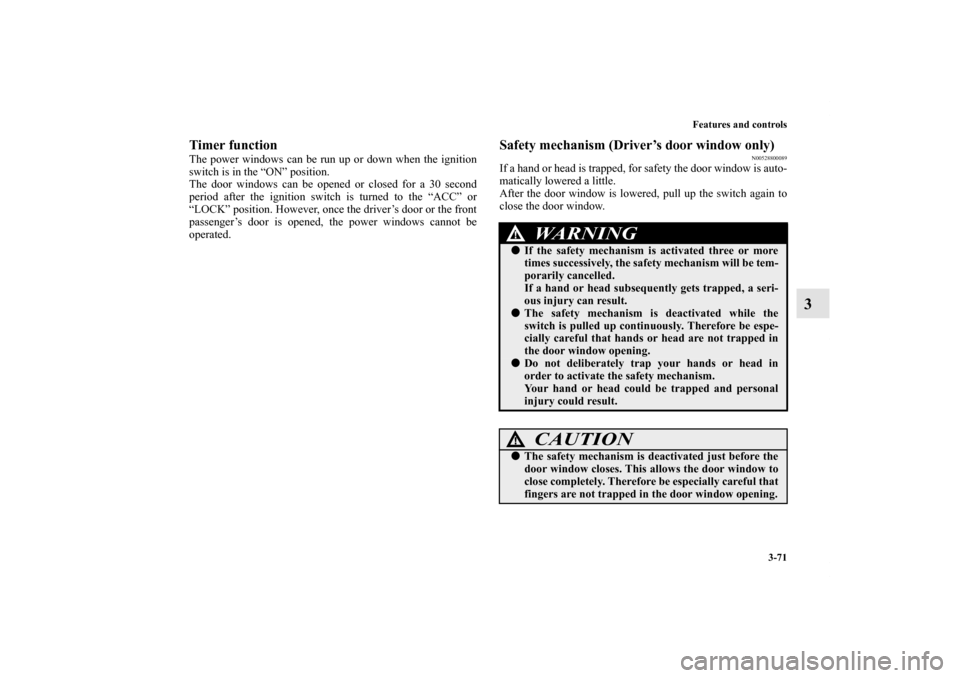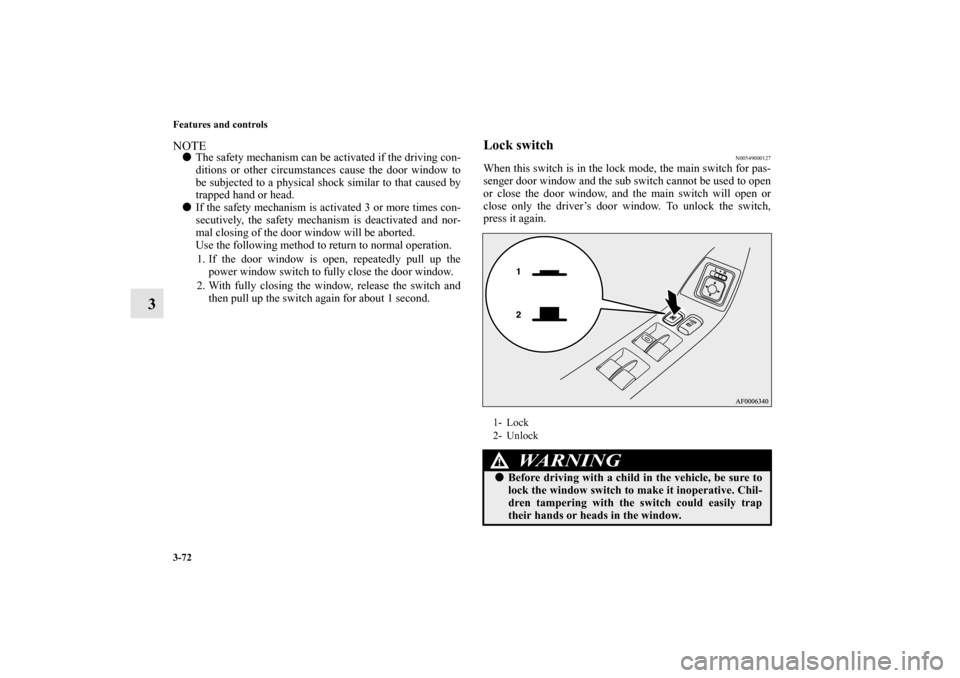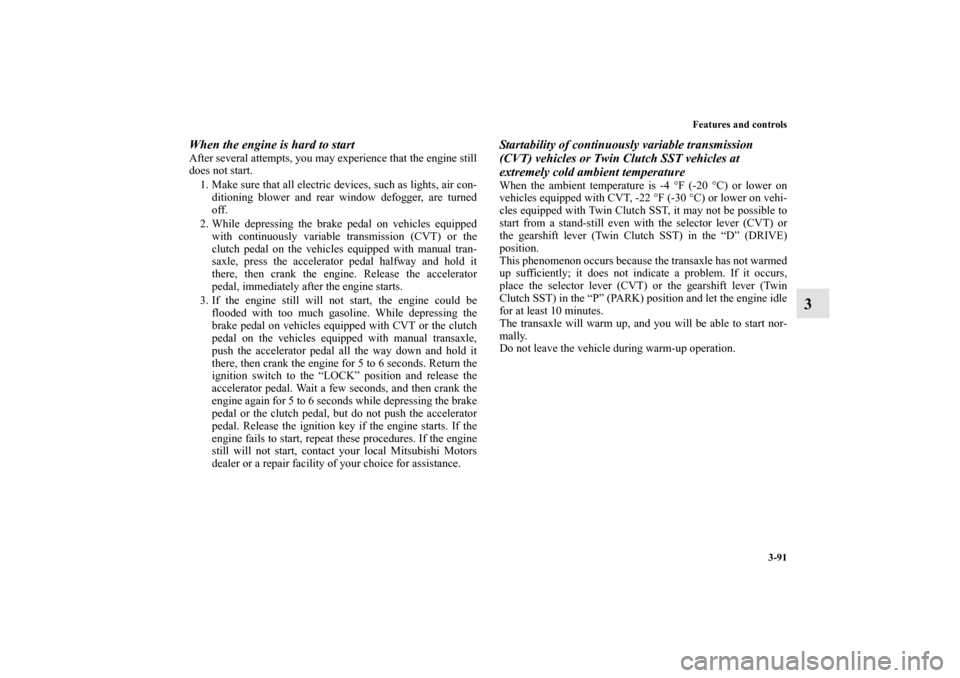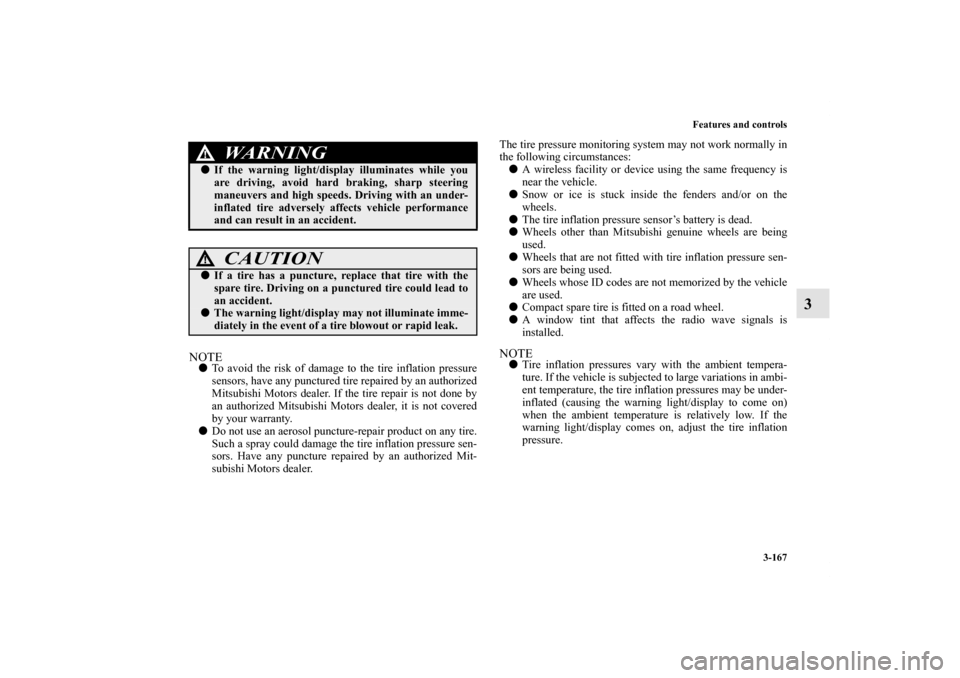Page 163 of 706
3-70 Features and controls
3
Sub switchEach sub switch can be used for its own passenger door win-
dow, unless the driver’s window lock switch is activated.
1- Driver’s door window switch
2- Front passenger door window switch
3- Left rear door window switch
4- Right rear door window switch
5- Window lock switch
1- Close (up)
2- Open (down)
BK0151000US.book 70 ページ 2012年3月29日 木曜日 午後6時8分
Page 164 of 706

Features and controls
3-71
3
Timer functionThe power windows can be run up or down when the ignition
switch is in the “ON” position.
The door windows can be opened or closed for a 30 second
period after the ignition switch is turned to the “ACC” or
“LOCK” position. However, once the driver’s door or the front
passenger’s door is opened, the power windows cannot be
operated.
Safety mechanism (Driver’s door window only)
N00528800089
If a hand or head is trapped, for safety the door window is auto-
matically lowered a little.
After the door window is lowered, pull up the switch again to
close the door window.
WA R N I N G
!�If the safety mechanism is activated three or more
times successively, the safety mechanism will be tem-
porarily cancelled.
If a hand or head subsequently gets trapped, a seri-
ous injury can result.�The safety mechanism is deactivated while the
switch is pulled up continuously. Therefore be espe-
cially careful that hands or head are not trapped in
the door window opening.�Do not deliberately trap your hands or head in
order to activate the safety mechanism.
Your hand or head could be trapped and personal
injury could result.
CAUTION
!�The safety mechanism is deactivated just before the
door window closes. This allows the door window to
close completely. Therefore be especially careful that
fingers are not trapped in the door window opening.
BK0151000US.book 71 ページ 2012年3月29日 木曜日 午後6時8分
Page 165 of 706

3-72 Features and controls
3
NOTE�The safety mechanism can be activated if the driving con-
ditions or other circumstances cause the door window to
be subjected to a physical shock similar to that caused by
trapped hand or head.
�If the safety mechanism is activated 3 or more times con-
secutively, the safety mechanism is deactivated and nor-
mal closing of the door window will be aborted.
Use the following method to return to normal operation.
1. If the door window is open, repeatedly pull up the
power window switch to fully close the door window.
2. With fully closing the window, release the switch and
then pull up the switch again for about 1 second.
Lock switch
N00549000127
When this switch is in the lock mode, the main switch for pas-
senger door window and the sub switch cannot be used to open
or close the door window, and the main switch will open or
close only the driver’s door window. To unlock the switch,
press it again.1- Lock
2- Unlock
WA R N I N G
!�Before driving with a child in the vehicle, be sure to
lock the window switch to make it inoperative. Chil-
dren tampering with the switch could easily trap
their hands or heads in the window.
BK0151000US.book 72 ページ 2012年3月29日 木曜日 午後6時8分
Page 166 of 706
Features and controls
3-73
3
What to do if you hear wind buffeting when driv-
ing
N00551400014
Wind buffeting can be described as the perception of pressure
on the ears or a booming or rumbling sound. Your vehicle may
exhibit wind buffeting when driving with one or both rear door
windows down or partially opened. This is a normal occur-
rence that can be minimized. If the buffeting occurs with the
rear door windows open, open the front door windows as well
as the rear door windows to minimize the condition.
Sunroof
(if so equipped)
N00511000669
The sunroof can be opened and closed with the ignition switch
in the “ON” position.
WA R N I N G
!�Do not stick your head, hands or anything else in the
sunroof opening. �Before operating the sunroof, make sure that noth-
ing can be trapped (head, hands, fingers, etc.).�Never leave a child (or other person who is incapa-
ble of safely operating the sunroof switch) alone in
the vehicle.
BK0151000US.book 73 ページ 2012年3月29日 木曜日 午後6時8分
Page 173 of 706
3-80 Features and controls
3
NOTE�When the gearshift lever or the selector lever is in the “R”
(REVERSE) position with the ignition switch in the “ON”
position, the rear-view camera image will be displayed on
the left portion of a type 3 mirror.
For details, refer to “Rear-view camera” on page 3-169.Adjust the inside mirror to maximize the view through the rear
window.
To adjust the vertical mirror positionIt is possible to move the mirror up and down to adjust its posi-
tion.
Ty p e 1
Ty p e 2
Ty p e 3BK0151000US.book 80 ページ 2012年3月29日 木曜日 午後6時8分
Page 177 of 706
3-84 Features and controls
3
To fold the mirrorThe outside mirror can be folded in toward the side window to
prevent damage when parking in tight locations.
Heated mirror
(if so equipped)
N00549300175
When the rear window defogger switch is pressed with the
engine running, the outside rearview mirrors are defogged or
defrosted. Current will flow through the heater element inside
the mirrors, thus clearing away frost or condensation.
The indicator light (A) will illuminate while the defogger is on.
The heater will be turned off automatically in about 20 min-
utes.
BK0151000US.book 84 ページ 2012年3月29日 木曜日 午後6時8分
Page 184 of 706

Features and controls
3-91
3
When the engine is hard to startAfter several attempts, you may experience that the engine still
does not start.
1. Make sure that all electric devices, such as lights, air con-
ditioning blower and rear window defogger, are turned
off.
2. While depressing the brake pedal on vehicles equipped
with continuously variable transmission (CVT) or the
clutch pedal on the vehicles equipped with manual tran-
saxle, press the accelerator pedal halfway and hold it
there, then crank the engine. Release the accelerator
pedal, immediately after the engine starts.
3. If the engine still will not start, the engine could be
flooded with too much gasoline. While depressing the
brake pedal on vehicles equipped with CVT or the clutch
pedal on the vehicles equipped with manual transaxle,
push the accelerator pedal all the way down and hold it
there, then crank the engine for 5 to 6 seconds. Return the
ignition switch to the “LOCK” position and release the
accelerator pedal. Wait a few seconds, and then crank the
engine again for 5 to 6 seconds while depressing the brake
pedal or the clutch pedal, but do not push the accelerator
pedal. Release the ignition key if the engine starts. If the
engine fails to start, repeat these procedures. If the engine
still will not start, contact your local Mitsubishi Motors
dealer or a repair facility of your choice for assistance.
Startability of continuously variable transmission
(CVT) vehicles or Twin Clutch SST vehicles at
extremely cold ambient temperatureWhen the ambient temperature is -4 °F (-20 °C) or lower on
vehicles equipped with CVT, -22 °F (-30 °C) or lower on vehi-
cles equipped with Twin Clutch SST, it may not be possible to
start from a stand-still even with the selector lever (CVT) or
the gearshift lever (Twin Clutch SST) in the “D” (DRIVE)
position.
This phenomenon occurs because the transaxle has not warmed
up sufficiently; it does not indicate a problem. If it occurs,
place the selector lever (CVT) or the gearshift lever (Twin
Clutch SST) in the “P” (PARK) position and let the engine idle
for at least 10 minutes.
The transaxle will warm up, and you will be able to start nor-
mally.
Do not leave the vehicle during warm-up operation.
BK0151000US.book 91 ページ 2012年3月29日 木曜日 午後6時8分
Page 260 of 706

Features and controls
3-167
3
NOTE�To avoid the risk of damage to the tire inflation pressure
sensors, have any punctured tire repaired by an authorized
Mitsubishi Motors dealer. If the tire repair is not done by
an authorized Mitsubishi Motors dealer, it is not covered
by your warranty.
�Do not use an aerosol puncture-repair product on any tire.
Such a spray could damage the tire inflation pressure sen-
sors. Have any puncture repaired by an authorized Mit-
subishi Motors dealer.The tire pressure monitoring system may not work normally in
the following circumstances:
�A wireless facility or device using the same frequency is
near the vehicle.
�Snow or ice is stuck inside the fenders and/or on the
wheels.
�The tire inflation pressure sensor’s battery is dead.
�Wheels other than Mitsubishi genuine wheels are being
used.
�Wheels that are not fitted with tire inflation pressure sen-
sors are being used.
�Wheels whose ID codes are not memorized by the vehicle
are used.
�Compact spare tire is fitted on a road wheel.
�A window tint that affects the radio wave signals is
installed.
NOTE�Tire inflation pressures vary with the ambient tempera-
ture. If the vehicle is subjected to large variations in ambi-
ent temperature, the tire inflation pressures may be under-
inflated (causing the warning light/display to come on)
when the ambient temperature is relatively low. If the
warning light/display comes on, adjust the tire inflation
pressure.
WA R N I N G
!�If the warning light/display illuminates while you
are driving, avoid hard braking, sharp steering
maneuvers and high speeds. Driving with an under-
inflated tire adversely affects vehicle performance
and can result in an accident.
CAUTION
!�If a tire has a puncture, replace that tire with the
spare tire. Driving on a punctured tire could lead to
an accident.�The warning light/display may not illuminate imme-
diately in the event of a tire blowout or rapid leak.
BK0151000US.book 167 ページ 2012年3月29日 木曜日 午後6時8分